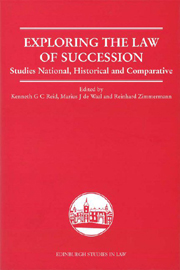Book contents
- Frontmatter
- Contents
- Preface
- List of Contributors
- List of Abbreviations
- Table of Cases
- 1 A Comparative Overview
- 2 Compulsory Heirship in Roman Law
- 3 Succession Law in Scotland – a Historical Perspective
- 4 Succession Law in South Africa – a Historical Perspective
- 5 Freedom of Testation and the Ageing Testator
- 6 Testamentary Conditions and Public Policy
- 7 Forfeiture Clauses and Events in Scots Law
- 8 Revocation of Wills by Changed Circumstances
- 9 Fideicommissary Substitutions: Scots Law in Historical and Comparative Perspective
- 10 The conditio si institutus sine liberis decesserit in Scots and South African Law
- 11 The New Dutch Law of Succession
- 12 Revocability of Mutual Wills
- 13 Succession Agreements in South African and Scots Law
- Index
13 - Succession Agreements in South African and Scots Law
Published online by Cambridge University Press: 12 September 2012
- Frontmatter
- Contents
- Preface
- List of Contributors
- List of Abbreviations
- Table of Cases
- 1 A Comparative Overview
- 2 Compulsory Heirship in Roman Law
- 3 Succession Law in Scotland – a Historical Perspective
- 4 Succession Law in South Africa – a Historical Perspective
- 5 Freedom of Testation and the Ageing Testator
- 6 Testamentary Conditions and Public Policy
- 7 Forfeiture Clauses and Events in Scots Law
- 8 Revocation of Wills by Changed Circumstances
- 9 Fideicommissary Substitutions: Scots Law in Historical and Comparative Perspective
- 10 The conditio si institutus sine liberis decesserit in Scots and South African Law
- 11 The New Dutch Law of Succession
- 12 Revocability of Mutual Wills
- 13 Succession Agreements in South African and Scots Law
- Index
Summary
INTRODUCTION
A succession agreement (or pactum successorium) is an agreement that seeks to regulate the succession to a person's estate (or an asset forming part of that person's estate) on his or her death. As such, it is an institution that occupies “a somewhat shadowy position between contract and testation”.
The agreement may seek to regulate succession either directly or indirectly. Almost all of the classic examples of pacta successoria fall into the latter category. Here the agreement seeks to affect the process of succession rather than to effect it. It does so by purporting to regulate the contents of a will. For example, the parties to the agreement might agree to appoint each other reciprocally as heir or legatee under their respective wills; or one party may promise to bequeath a particular asset to another by way of legacy; or a party may promise not to revoke a legacy, or not to make a will at all.
In its direct form, the pactum successorium is more ambitious: it bypasses the will altogether and seeks itself to effect the succession by contract. An example of such an agreement would be where two parties directly and reciprocally appoint each other as heir in terms of their agreement. More generally, it might perhaps be said that any agreement purporting to effect a post-mortem disposition of an asset falls into this category.
- Type
- Chapter
- Information
- Exploring the Law of SuccessionStudies National Historical and Comparative, pp. 226 - 246Publisher: Edinburgh University PressPrint publication year: 2007



